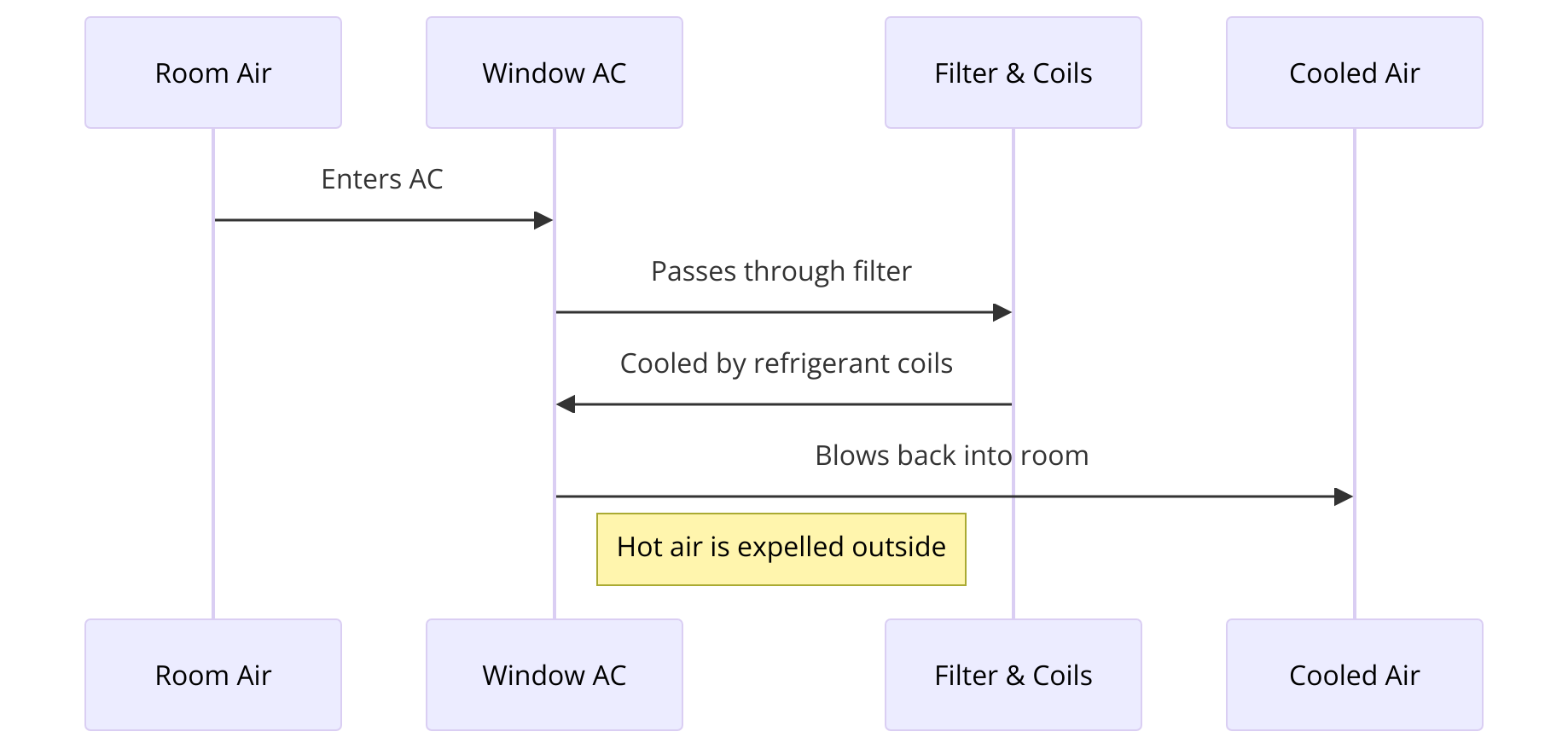Table of Contents
Does a Window AC pull Air from Outside: Separating Fact from Fiction
When it comes to cooling your space, window air conditioners are a popular choice for their efficiency and convenience.
However, there’s a common misconception that these units simply pull in cool air from the outside.
In reality, the way window air conditioners cool your room involves a bit more complexity, especially when distinguishing between the two main types: refrigerated and evaporative air conditioners.
Where Do Window ACs Pull Air From?
Contrary to popular belief, most window air conditioners do not pull air from outside to cool the room. Instead, they recirculate the indoor air, cooling it through a refrigeration cycle. The only exception is when the unit is set to “vent” or “fan” mode, which may introduce a small amount of outdoor air for ventilation purposes.
Types of Window Air Conditioners: Refrigerated vs. Evaporative
- Refrigerated Air Conditioners: These are the more commonly used units in modern homes. They work by recirculating the indoor air, cooling it by passing it over coils filled with refrigerant. The warm air is expelled outside, making this system highly efficient for lowering room temperature without introducing outside air.
- Evaporative Air Conditioners (Swamp Coolers): Less common but highly effective in dry climates, evaporative coolers pull in warm outside air and cool it by passing it over water-saturated pads. This process adds moisture to the air, which can be a boon in arid conditions but less desirable in humid climates.
How Refrigerated Window Air Conditioners Work
Refrigerated window air conditioners operate on a simple yet effective principle known as the refrigeration cycle. This process involves four key components: the compressor, condenser coil, expansion valve, and evaporator coil. Here’s a step-by-step breakdown of how these units cool your space:
- Air Intake: The unit draws in warm room air through a grille at the front of the air conditioner.
- Air Filtration: As the air passes into the unit, it goes through a filter, removing dust, pollen, and other airborne particles.
- Cooling: The cleaned air then passes over the evaporator coil. The coil is filled with a refrigerant, which absorbs the heat from the air, cooling it down. This process also removes excess moisture from the air, helping to reduce humidity levels in the room.
- Circulation: The now-cooled air is circulated back into the room by a fan, providing a comfortable and cooler environment.
- Heat Expulsion: The absorbed heat is transferred to the refrigerant and moved to the condenser coil located at the back (outside part) of the unit. Here, the heat is released to the outside air, and the cooled refrigerant is cycled back to the evaporator coil to continue the cooling process.
- Continuous Cycle: This cycle repeats continuously to maintain the desired room temperature set by the thermostat.
It’s important to note that the entire process occurs within the unit, without the need to bring in outside air, making refrigerated air conditioners highly efficient for indoor cooling.
Below is a simple diagram illustrating this cooling process:

By understanding the mechanics behind refrigerated window air conditioners, you can appreciate the technology that keeps your living or workspace comfortable during warmer months.
Do Window ACs Filter Air?
Yes, window air conditioners do filter the air as part of the cooling process. The built-in air filters capture dust, pollen, and other airborne particles from the indoor air. However, these filters have limitations and should be cleaned or replaced regularly to maintain air quality and unit efficiency.
 How Window Air Conditioners Use Outdoor Air
How Window Air Conditioners Use Outdoor Air
- Fan Mode: This setting allows the unit to function like a traditional fan, introducing a small amount of outside air to mix with the indoor air, providing ventilation without significant cooling.
- Ventilation: The side vents on a window air conditioner are not for pulling in outdoor air to cool but for drawing air into the condenser coil compartment to prevent the unit from overheating.
- Evaporative Cooling: Exclusive to evaporative coolers, this method involves pulling outdoor air through moistened pads, cooling it before distributing it indoors.
Do Window ACs Recirculate Air?
Yes, Window air conditioners primarily recirculate the indoor air. In the cooling mode, they take in room air, cool it down, and then release it back into the room. This recirculation process ensures that the air within the space is continuously cooled to the desired temperature.
Do Portable Air Conditioners Pull Air from Outside?
Portable air conditioners, much like window units, primarily recirculate indoor air. However, they do require an exhaust hose to expel hot air outside, which can lead to a slight negative pressure that might draw in some outdoor air through leaks or other openings in the room.
Do Wall Air Conditioners Bring in Outside Air?
Wall air conditioners, similar to window units, mainly recirculate indoor air for cooling. Some models may offer a venting option that allows for the introduction of a small amount of outside air, but this is not their primary function. The main goal is to cool the indoor air and maintain a comfortable indoor environment.
Pros and Cons of Each Type
- Refrigerated Air Conditioners:
- Pros: Provide cooler air, require less maintenance, do not need a water source, and effectively reduce indoor humidity.
- Cons: Can be louder and must exhaust warm air outside, which requires proper installation.
- Evaporative Air Conditioners:
- Pros: Energy-efficient in suitable climates, add humidity to dry air, and do not require venting hot air outside.
- Cons: Not as effective in humid conditions, need a continuous water supply, and require more frequent maintenance to prevent mold and bacteria.
 Choosing the Right Air Conditioner for Your Space
Choosing the Right Air Conditioner for Your Space
The choice between refrigerated and evaporative window air conditioners depends on several factors, including your local climate, window accessibility, and maintenance preferences. Refrigerated units are a go-to for their convenience and cooling power, ideal for most residential settings. On the other hand, evaporative coolers offer an eco-friendly alternative in dry, hot climates, where the added humidity can be a comfort rather than a nuisance.
Maintenance Matters
Regardless of the type, maintaining your window air conditioner is crucial for optimal performance and longevity. Regular cleaning, filter changes, and checks for water buildup (in the case of evaporative coolers) can prevent common issues like mold growth and inefficiency.
In Summary
Window air conditioners, whether refrigerated or evaporative, offer effective solutions for staying cool. Understanding the differences and operational nuances of each can help you make an informed decision that best meets your needs, ensuring comfort and efficiency in your home or office.
FAQ
- How does a window air conditioner work?
- Answer: A window air conditioner cools indoor air by passing it over cold coils filled with refrigerant. It expels hot air outside and recirculates the cooled air back into the room.
- Can window air conditioners bring in fresh air from outside?
- Answer: Most window air conditioners recirculate indoor air for cooling. However, some models have a “vent” or “fan” mode that allows a small amount of fresh air from outside to mix with the indoor air.
- Do window air conditioners improve air quality?
- Answer: Window air conditioners can improve air quality by filtering out dust, pollen, and other airborne particles through their built-in air filters. Regular cleaning or replacing these filters is essential for maintaining air quality.
- Is it possible to use a window air conditioner in a room without windows?
- Answer: It is not recommended to use a window air conditioner in a room without windows, as these units need to expel hot air outside. Alternative cooling solutions, such as portable air conditioners with an exhaust hose, might be more suitable.
- How often should I clean or maintain my window air conditioner?
- Answer: It’s advisable to clean or check the air filters monthly during peak usage and perform a thorough cleaning of the entire unit at least once a year to ensure optimal performance and longevity.
- Can window air conditioners be used for heating?
- Answer: Some window air conditioner models come with a heat pump function, allowing them to provide heating in addition to cooling. Check the specifications of your unit to see if it has this feature.
- Are window air conditioners energy-efficient?
- Answer: The energy efficiency of window air conditioners varies by model and age. Look for units with an Energy Star rating for better energy efficiency.
- How do I choose the right size window air conditioner for my room?
- Answer: The size of the air conditioner should be based on the room’s square footage. Generally, you need about 20 BTU (British Thermal Units) of cooling power for each square foot of space.
- Can window air conditioners cause security issues?
- Answer: Proper installation can mitigate most security concerns with window air conditioners. Ensure the unit is securely mounted and consider adding window locks or security brackets.
- What should I do with my window air conditioner during the winter?
- Answer: In colder climates, it’s best to remove the unit to prevent drafts. If removal isn’t possible, cover the exterior of the unit with an insulating wrap to protect it and reduce cold air infiltration.


 How Window Air Conditioners Use Outdoor Air
How Window Air Conditioners Use Outdoor Air Choosing the Right Air Conditioner for Your Space
Choosing the Right Air Conditioner for Your Space